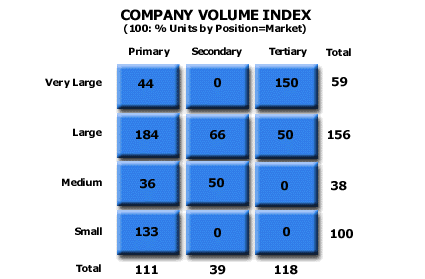Analysis 12: Company Volume Index on the Size/Role Matrix
EXHIBITS:

HOW TO INTERPRET THE ANALYSIS: This company is strong in the Primary and Tertiary Roles and relatively weak in the Secondary Role. Among customer size segments, it has its greatest strength with the Large and Small customers. It is relatively weak with Very Large and Medium customers. If the industry sold 50% of its volume to Very Large customers, this company would have sold only 29.5% (50% x 59 = 29.5%)of its sales to Very Large customers. If the industry sold 65% of its total units into the Primary Role position, this company would have sold 72% (65% x 111 = 72%) of its volume into the Primary Role position.
PURPOSE: The purpose of the analysis is to bring the company a better understanding of how customers evaluate the company's performance relative to competition. This analysis indicates where the company is relatively strong and weak in each position in the marketplace.
APPROACH: A size segment is a combination of customer size along with the role within the customer relationship. To arrive at this analysis the company totals its sales by position on the matrix so that each position on the matrix shows a percentage of the company's total sales. The percentages summed across equal the total sales of the company by customer size segment. The company would do a similar analysis for the industry as a whole. Then it would divide the industry percentage of sales by position into its own percentage of sales by position. It multiplies that fraction by 100 to produce an index. An index is a measure of the performance of one entity relative to another entity. The index is the ratio of the performance of the first entity divided by the performance of the second and then multiplied by 100. An index above 100 indicates that the first entity has a higher result than the second entity. An index below 100 indicates that the first entity has a lower result than the second. In this analysis, a number above 100 indicates that the company is stronger than average in the market in that segment. A number below 100 indicates that the company is relatively weak in that position. In the example above, the company is very strong in the Large Primary and Small Primary segments as well as with the Very Large Tertiary segment. It is notably weak with the Very Large Primary position. Overall, the company is strong as a Primary supplier and as a supplier to Large and Small customers. It is weak in the Secondary role and with the Very Large and Medium customers. This is the profile of second tier supplier in the market. Before the company begins its work on improving its value proposition, it should understand the reasons for these relative strengths and weaknesses. Return to Diagnose Segments: Position on the Matrix Return to Basic Strategy Guide Step 8 |
| Recommended Reading |
| For a greater overall perspective on this subject, we recommend the following related items:
Analyses:
Symptoms and Implications: Symptoms developing in the market that would suggest the need for this analysis.
Perspectives: Conclusions we have reached as a result of our long-term study and observations.
|
